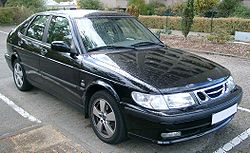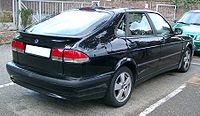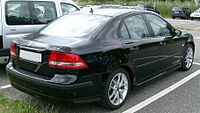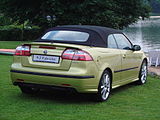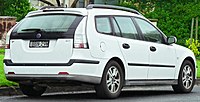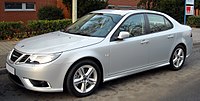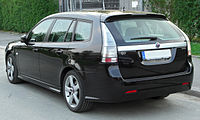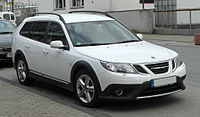Saab 9-3
| Saab 9-3 | |
|---|---|
| Production period: | 1998-2011; 2013-2014 |
| Class : | Middle class |
| Body versions : | Hatchback , sedan , station wagon , Combi Coupé , Cabriolet |
| Previous model: | Saab 900 |
| Successor: | NEVS 9-3 (China) |
The Saab 9-3 is a front-wheel drive , five-seater car model introduced by the Swedish manufacturer Saab in spring 1998 . In December 2011, production was stopped due to the bankruptcy of Saab. Production was continued again between autumn 2013 and mid-2014.
9-3 I (type YS3D, 1998-2003)
| 1st generation | |
|---|---|
|
Saab 9-3 sedan (1998-2003) |
|
| Production period: | 1998-2003 |
| Body versions : | Station wagon , station wagon coupé , cabriolet |
| Engines: |
Otto engines : 2.0–2.3 liters (96–169 kW) Diesel engines : 2.2 liters (85–92 kW) |
| Length: | 4630 mm |
| Width: | 1712 mm |
| Height: | 1427 mm |
| Wheelbase : | 2606 mm |
| Empty weight : | 1295-1560 kg |
| Stars in the Euro NCAP - Crash Test |
|
The first 9-3 was the direct successor to the Saab 900 II.
Due to the numerous changes (depending on the source and counting method 450 to 1100) mainly to the mechanics, although not so much to the appearance, the model change cannot be viewed as a “facelift” in the true sense. The most noticeable distinguishing features are the modified tailgate with the license plate now higher up, between the taillights, and the slightly modified radiator grille. In order to keep crash safety up to date, there are now standard side airbags that are integrated into the new seats.
The first Saab 9-3 was available as a five-door hatchback, a three-door station wagon and a convertible . The drag coefficient (c w ) was 0.34; for the Viggen model, however, with a front spoiler and improved underbody airflow 0.31. The add-on parts are also available as an aerodynamic kit. From model year 1999 is also the first time Saab one of Steyr-Puch developed and Opel in Kaiserslautern produced diesel engine with 2.2 liters of displacement , a VP44- injection pump from Bosch and two balancer shafts have been offered with 85, from model year 2001 92 kW.
After production of the limousine in Trollhättan was discontinued in the summer of 2002, production was relocated to Nystad / Finland. Production of the first 9-3 series ended there on April 25, 2003. Of the 7,789 sedans built in Finland, over 6,000 were of the Viggen type. 326,370 copies of the 9-3 I were made.
Engines
(Erste Generation)
| model | engine | Displacement | Type | power | Torque | 0-100 km / h | V max | construction time | comment |
|---|---|---|---|---|---|---|---|---|---|
| Petrol engines | |||||||||
| 2.0i | B 204I | 1985 cc | R4, 16V | 96 kW (131 hp) at 5500 min -1 | 177 Nm at 4300 min -1 | 11.0 s | 200 km / h | 02 / 1998-12 / 2000 | Basic engine |
| 2.0t | B 204E | 1985 cc | R4, 16V, turbo | 113 kW (154 hp) at 5500 min -1 | 219 Nm at 2600 min -1 | 8.8 s | 210 km / h | 02 / 1998-12 / 2000 | |
| 2.0t | B 205E | 1985 cc | R4, 16V, turbo | 110 kW (150 hp) at 5500 min -1 | 240 Nm at 1800 min -1 | 8.5 s | 215 km / h | 01 / 2001-08 / 2002 | |
| 2.0 turbo | B 204L | 1985 cc | R4, 16V, turbo | 136 kW (185 hp) at 5500 min -1 | 263 Nm at 2100 min -1 | 8.0 s | 230 km / h | 02 / 1998-10 / 1999 | |
| 2.0 turbo | B 205L | 1985 cc | R4, 16V, turbo | 136 kW (185 hp) at 5500 min -1 | 263 Nm at 2100 min -1 | 8.0 s | 230 km / h | 10 / 1999-08 / 2002 | |
| 2.0 turbo | B 204R | 1985 cc | R4, 16V, turbo | 147 kW (200 hp) at 5500 min -1 | 283 Nm at 2300 min -1 | 7.3 s | 235 km / h | 10 / 1999-08 / 2002 | |
| 2.0 turbo | B 205R | 1985 cc | R4, 16V, turbo | 151 kW (205 hp) at 5500 min -1 | 280 Nm at 2200 min -1 | 7.3 s | 235 km / h | 10 / 1999-04 / 2003 | |
| 2.3i | B 234I | 2290 cc | R4, 16V | 110 kW (150 hp) at 5700 min -1 | 212 Nm at 3800 min -1 | 10.0 s | 204 km / h | 02 / 1998-02 / 1999 | |
| 2.3 Turbo | B 235R | 2290 cc | R4, 16V, turbo | 165 kW (224 hp) at 5500 min -1 | 342 Nm at 2500 min -1 | 6.8 s | 250 km / h | 03 / 1999-06 / 1999 | |
| 2.3 Turbo | B 235R | 2290 cc | R4, 16V, turbo | 169 kW (230 hp) at 5500 min -1 | 350 Nm at 1900 min -1 | 6.8 s | 250 km / h | 10 / 1998-06 / 2000 | |
| Diesel engines | |||||||||
| 2.2 TiD | X22DTR | 2171 cc | R4, 16V, turbo | 85 kW (115 hp) at 4300 min -1 | 260 Nm at 1800 min -1 | 10.9 s | 200 km / h | 02 / 1998-10 / 2000 | only available with manual control |
| 2.2 TiD | D 223L | 2171 cc | R4, 16V, turbo | 92 kW (125 hp) at 4300 min -1 | 280 Nm at 1500 min -1 | 10.5 s | 200 km / h | 11 / 2000-04 / 2003 | only available with manual control |
The Trionic 5 motor control version was used from the start of production. This was replaced from model year 2000 by the newer version Trionic 7.
9-3 II (type YS3F, 2002–2011)
| YS3F | |
|---|---|
|
Saab 9-3 sedan (2002-2007) |
|
| Production period: | 2002-2011; 2013-2014 |
| Body versions : | Sedan , station wagon , convertible |
| Engines: |
Otto engines : 1.8–2.8 liters (90–206 kW) Diesel engines : 1.9–2.2 liters (88–132 kW) |
| Length: | 4635-4654 mm |
| Width: | 1762 mm |
| Height: | 1466-1492 mm |
| Wheelbase : | 2675 mm |
| Empty weight : | 1440-1765 kg |
| Stars in the Euro NCAP - Crash Test |
|
The new model, based on the GM Epsilon platform , followed in September 2002 even before production of the predecessor ended .
In contrast to the 900 from 1993 and the 9-3 from 1998, the new 9-3 was no longer available with a hatchback, but as a notchback sedan. According to market research results, this should be the most appealing form with the highest sales figures at this point in time. The c w value is 0.28. The convertible followed in August 2003. Contrary to popular belief that the Saab 9-3 II is just a modified Opel Vectra C, only 30 percent of all parts on this vehicle come from the GM shelf. The remaining 70 percent have been developed by Saab. This is also the reason why GM does not have license rights to this car (unlike the Saab 9-5II and Saab 9-4X).
From March 2005, the 9-3 was offered as a station wagon (c w value 0.33; however, with a larger frontal area than the Saab 9-3 I had). As a so-called sports or lifestyle station wagon, it serves the same target group as the mid-range station wagons from BMW , Audi and Mercedes-Benz , for example , which means that the manufacturer has put driving or stylistic aspects under the term "sport" before pure transport qualities. In this orientation ( underlined by the name SportCombi ), the 9-3 station wagon follows its larger sister model, the Saab 9-5 station wagon. Accordingly, the trunk volume fell from 494 l in the 9-3 I to 425 l (sedan) or 419 l (station wagon).
In terms of diesel engines, there was only a slightly revised version of the 2.2-liter engine from the previous model until 2004. From 2004, the 1.9-liter diesel engines with 110 kW (16 valves) and 88 kW (8 valves) developed in cooperation between GM and Fiat will be available. These are now equipped with a maintenance-free particle filter as standard and meet the Euro 4 standard . Since these engines are also used in almost all Opel, Alfa and Fiat models, procurement of spare parts is usually simple and inexpensive. As with all modern diesel engines, defective swirl flaps and the EGR valve (exhaust gas recirculation) are the most common sources of error. All 1.9 TiD models were also available with a 6-speed manual gearbox or a 6-speed automatic. From 2006 to 2009 Saab also manufactured the Cadillac BLS , which is technically almost the same as the 9-3 II and was developed together with Cadillac .
The Saab 9-3 II also has a high level of accident safety and achieved 5 out of 5 stars in the crash test in 2002.
As standard there were:
- Driver and passenger airbags
- Side airbags
- Head airbags (all the way to the rear)
- Anti-lock braking system (ABS)
- Electronic stability program (ESP)
- Drive slip control
- Cornering brake control
- Mechanical brake booster
- electronic brake assist
- 2nd generation active headrests at the front
- Three-point automatic seat belts on all five seats
- ComSense (Delays messages from the on-board computer in dangerous situations)
Facelift
2007
With the appearance of the 9-3 SportCombi, the interior was revised and now offered a new navigation system, a different air conditioning control and slight design changes in the speedometer area.
In autumn 2007, the front design was based on the Saab 9-2X , which was only sold in the USA . Two BioPower engines with turbocharging for all model variants were added to the engine range - a 1.8t with 129 kW (175 PS) and a 2.0t with 147 kW (200 PS) (each 18 kW more than when running on premium gasoline). A 1.9 TTiD with biturbo, 132 kW (180 PS) and 400 Nm (370 Nm with automatic transmission) was introduced as the new diesel engine.
From 2008 the 9-3 was also available with all-wheel drive (brand name XWD, a fourth generation Haldex clutch with electronic-hydraulic control, including the rear differential gear ). The limited special model Turbo X with 206 kW (280 PS) was presented as the first all-wheel drive model at the end of 2007. This vehicle was limited to 2,000 units.
In the spring of 2009, another model based on the station wagon with an SUV look (raised, black plastic cladding) was presented, which was sold as the 9-3X from autumn 2009.
2011
In spring 2011 the 9-3 got another facelift, with which it received the additional name Griffin . This version received, among other things, modifications to the front and rear based on the Saab 9-5 II, an interior with improved material appearance and updated engines such as direct injection for gasoline engines and twin-scroll turbochargers for the 1.9-liter diesel engines. The stern was also changed. As with the first Saab models, the missing Greif logo was replaced by the classic lettering.
From then on, all engines also met the Euro 5 standard.
The market launch of the third generation of the 9-3 was planned for the end of 2012. For this, both the Epsilon II platform, also used in the new 9-5, and the smaller Delta platform ( known from the Opel Astra J , for example ) were originally investigated, but finally the decision was made to use the current one, already compared to the Epsilon I Platform to further develop the modified platform of the 9-3 II. However, due to Saab's bankruptcy, these plans were no longer realized.
Dimensions
| model | Length (mm) | width (mm) | Height (mm) | Wheelbase (mm) | Track v / h (mm) | Empty weight kg) |
| Sports sedan | 4647 | 1762 (2038) | 1473 | 2675 | 1524/1506 | 1440-1680 |
| SportCombi | 4670 | 1762 (2038) | 1498 | 2675 | 1524/1506 | 1475-1765 |
| Cabriolet | 4647 | 1762 (2038) | 1437 | 2675 | 1524/1506 | 1650-1715 |
Technical specifications
(Zweite Generation)
| model | Displacement | Type | Power at 1 / min | Torque, Nm at 1 / min |
Consumption l / 100 km (automatic) |
0-100 km / h s |
V max km / h |
construction time |
|---|---|---|---|---|---|---|---|---|
| Gasoline engine | ||||||||
| 1.8i | 1769 cc | R4, 16V | 90 kW (122 hp) at 6000 | 167 at 3800 | 7.7 | 11.5 | 200 | 01 / 2004-04 / 2009 |
| 1.8t | 1998 cc | R4, 16V, turbo | 110 kW (150 PS) at 5500 | 240 at 2000 | 7.5 (8.5) | 9.5 | 210 | 09 / 2002–12 / 2011 |
| 2.0t | 1998 cc | R4, 16V, turbo | 129 kW (175 hp) at 5500 | 265 at 2500 | 7.9 (9.0) | 8.5 | 225 | 09 / 2002–12 / 2011 |
| 2.0T | 1998 cc | R4, 16V, turbo | 154 kW (210 hp) at 5500 | 300 at 2500 | 8.1 (9.1) | 7.5 | 235 | 09 / 2002–12 / 2011 |
| 2.8 Turbo V6 | 2792 cc | V6, 24V, turbo | 184 kW (250 hp) at 5500 | 350 at 2000-2750 | 10.2 (10.8) | 6.7 | 250 | 03 / 2005-09 / 2007 |
| 2.8 Turbo V6 | 2792 cc | V6, 24V, turbo | 188 kW (255 hp) at 5500 | 350 at 1800-5000 | 10.2 (10.8) | 6.7 | 250 | 10/2007–05/2008 |
| 2.8 Turbo V6 | 2792 cc | V6, 24V, turbo | 206 kW (280 hp) at 5500 | 400 at 2150-4500 | 10.9 (11.4) | 6.2 | 250 | 05/2008–12/2011 |
| diesel | ||||||||
| 1.9 TiD | 1910 cc | R4, 8V, turbo | 88 kW (120 PS) at 4000 | 280 at 2000-2750 | 5.4 | 11.5 | 200 | 09 / 2004–12 / 2010 |
| 1.9 TTiD | 1910 cc | R4, 16V, bi-turbo | 96 kW (130 PS) at 4000 | 320 at 1500 | 4.5 | 10.9 | 210 | 01/2011–12/2011 |
| 1.9 T iD | 1910 cc | R4, 16V, turbo | 110 kW (150 PS) at 4000 | 320 at 2000-2750 | 5.8 (7.2) | 9.5 | 210 | 09 / 2004–12 / 2010 |
| 1.9 TTiD | 1910 cc | R4, 16V, bi-turbo | 118 kW (160 hp) at 4000 | 360 at 1750 | 4.5 | 9.5 | 225 | 01/2011–12/2011 |
| 1.9 TT iD | 1910 cc | R4, 16V, bi-turbo | 132 kW (180 PS) at 4000 | 400 at 1800-2750 | 5.9 (6.7) | 8.5 | 230 | 10/2007–12/2011 |
| 2.2 TiD | 2171 cc | R4, 16V, turbo | 92 kW (125 PS) at 4000 | 280 at 1500 | 6.6 | 11.0 | 200 | 09 / 2002-08 / 2004 |
| Bio-ethanol | ||||||||
| 2.0t BioPower | 1998 cc | R4, 16V, turbo | 129 kW (175 hp) at 5500 | 265 at 2500-3500 | 7.5 (8.5) | 8.4 | 225 | 01/2007–12/2010 |
| 2.0t biopower | 1998 cc | R4, 16V, turbo | 120 kW (163 hp) at 5500 | 320 at 1750 | 6.7 (7.9) | 01/2011–12/2011 | ||
| 2.0t BioPower | 1998 cc | R4, 16V, turbo | 147 kW (200 hp) at 5500 | 300 at 2500-4000 | 7.9 (9.0) | 7.9 | 230 | 05/2009–12/2010 |
| 2.0T biopower | 1998 cc | R4, 16V, turbo | 162 kW (220 PS) at 5300 | 350 at 2500 | 6.7 (7.9) | 01/2011–12/2011 | ||
- Note: The TiD or TTiD lettering of the 1.9 l model with 150 or 180 hp differs from the other diesel models by the red letter T.
9-3 II (type YTN, 2013-2014)
From September 18, 2013, production of the 9-3 at the Trollhättan plant started again. The lead was the new owner of the production facilities, NEVS , who initially also owned the rights to use the Saab brand name . Deviations from the previous version resulted inevitably from replacing those parts on which GM held the patents or whose manufacturers no longer existed.
The 2.0-liter engine of the 9-3 now developed 162 kW (220 hp) with a turbocharger. The Saab 9-5 II, which was manufactured from mid-2010, already had this engine .
From April 15, 2014, customers from Sweden were able to take a test drive at twenty selected dealers. Orders could only be placed via the Internet, which is rarely the case with cars.
Production of the 9-3 II (type YTN) was ended again in mid-2014.
Electric version
A version with an electric drive was also planned for a later date , which has not yet got beyond the prototype stage. According to the plan, the production numbers were originally to be ramped up in autumn 2014, in order to start selling the model on the Chinese market in summer 2015 [obsolete] . NEVS had to apply for bankruptcy protection in 2014 and lost the rights to use the Saab brand name , which were not regained even after leaving bankruptcy protection in March 2015.
In mid-2016, NEVS again announced that it would be delivering an electric car based on the Saab 9-3 from 2017. After the withdrawal of the naming rights by Saab AB , however, these would be marketed under its own name NEVS .
Racing
The Saab 9-3 Viggen Pikes Peak was specifically for the hill climb Pikes Peak International Hill Climb rebuilt in 2000th For this purpose, the 2.0-l turbo engine with 16 valves (B204L) from the previous Saab 900 model was tuned by the Trollhättan- based company Trollspeed and achieved 552 kW (750 PS), two years later 588 kW (800 PS). In 2000, the driver Per Eklund was able to set a class record of 11: 20.580 minutes in the “Pikes Peak Open” class, which lasted until 2012. In 2002, Per Eklund even achieved a time of 11: 13.200 minutes with the improved vehicle, but this time in the "Unlimited" class. The car accelerates from 0 to 100 km / h in 2.3 seconds and has all-wheel drive with programmable differential locks .
Web links
Individual evidence
- ↑ http://www.euroncap.com/en/ratings-rewards/latest-safety-ratings/en/results/saab/9-3/15526
- ↑ valmet-automotive.com ( Memento of the original from July 23, 2008 in the Internet Archive ) Info: The archive link was inserted automatically and has not yet been checked. Please check the original and archive link according to the instructions and then remove this notice.
- ↑ saabhistory
- ↑ autosieger.de
- ↑ atzonline.de ( page no longer available , search in web archives ) Info: The link was automatically marked as defective. Please check the link according to the instructions and then remove this notice.
- ↑ rp-online.de ( Memento of the original from August 19, 2009 in the Internet Archive ) Info: The archive link was automatically inserted and not yet checked. Please check the original and archive link according to the instructions and then remove this notice.
- ↑ saabsunited.com
- ↑ blogs.motortrend.com
- ↑ saabsunitedny.com ( Memento of the original from April 6, 2010 in the Internet Archive ) Info: The archive link was inserted automatically and has not yet been checked. Please check the original and archive link according to the instructions and then remove this notice.
- ↑ First Saabs delivered to partners in Sweden ( Memento of the original from April 16, 2014 in the Internet Archive ) Info: The archive link was automatically inserted and not yet checked. Please check the original and archive link according to the instructions and then remove this notice. , Press release from Saab
- ↑ Resumption of production Saab 9-3 in autumn 2013 ( Memento of the original from October 4, 2013 in the Internet Archive ) Info: The archive link was automatically inserted and not yet checked. Please check the original and archive link according to the instructions and then remove this notice.
- ↑ Saab 9-3: New Plans: Second Chance for the 9-3 AutoBILD online, March 22, 2013.
- ↑ Joey Wang: Official photos of the NEVS Saab 9-3 CarNewsChina Internet portal, December 3, 2013 (in English)
- ↑ Uli Baumann: Saab 9-3 Electric: Sweden show electric prototypes. ( Memento of the original from September 3, 2014 in the Internet Archive ) Info: The archive link was inserted automatically and has not yet been checked. Please check the original and archive link according to the instructions and then remove this notice. auto, motor und sport online, August 21, 2014
- ↑ Antony Ingram: First electric Saab 9-3 models built, will go to China test fleet. GreenCarReports Internet portal, April 8, 2014 (English)
- ↑ Green Motors: Saab: First electric car in 2017, four more Stromer in 2018
- ↑ nevs.com: NEVS launches its new trademark ( memento of the original from September 14, 2016 in the Internet Archive ) Info: The archive link was inserted automatically and has not yet been checked. Please check the original and archive link according to the instructions and then remove this notice. , June 21, 2016
